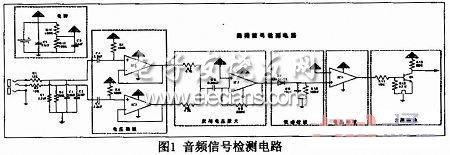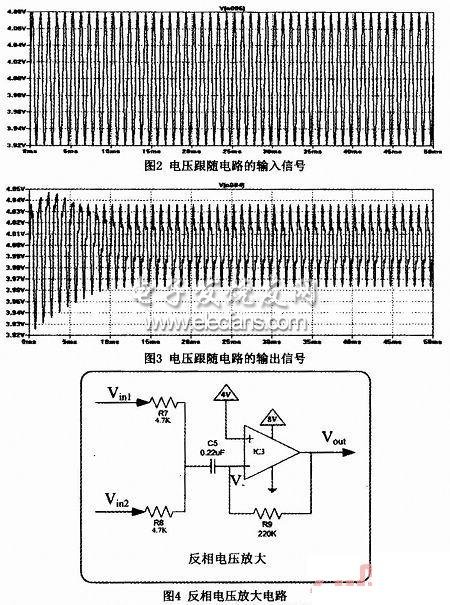At present, there are more and more functions of car audio, from radio, CD to DVD, Bluetooth, navigation and other functions. At the same time, AUX (auxiliary input) is also a necessary function. It can input portable audio equipment such as MP3 and iPOD of users in the car. Go to the car audio for playback. The designed automatic detection and playback circuit is now analyzed and explained.
1 Circuit composition
This circuit consists of 6 parts: power circuit, voltage follower circuit, voltage inverting amplifier circuit, low-pass filter circuit, comparison circuit, and detection output circuit. The circuit diagram is shown in Figure 1:

2 Circuit analysis
2.1 Power circuit
The power supply is composed of 8V and 4V. 8V provides power for the op amp. At the same time, R13 and R14 are used to generate the bias voltage of the op amp 4V, and the input bias voltage of 4 op amps is provided.
2.2 Voltage following circuit
In the voltage follower circuit, op amps IC1 and IC2 function as voltage followers, and the positive signal input terminal is superimposed with a DC bias signal and passed to the next stage without change. The input impedance of the op amp voltage follower is very large, and the output impedance is very small. Due to the large input impedance, the input voltage is transferred to the op amp almost without loss, while the output impedance is small, and the output signal is almost completely passed to the subsequent circuit. The op amp has a good buffering effect, blocking the impact of the subsequent stage on the input signal.
80mV / 1kHz sinusoidal signal is used for simulation in PSPICE. The input and output signals of the following circuit are shown in Figure 2 and Figure 3.

2.3 Inverting voltage amplifier circuit
See Figure 4 for the circuit diagram.
The amplification of the AC signal by this circuit (where R7 = R8) can be derived from the following formula:
(VIN1-V-) / R7 + (VIN2-V-) R8 = (V--VOUT) / R9 (1)
VOUT = VIN1 (-R9 / R7) + VIN2 (-R9 / R8) (2)
VOUT = (VIN1 + VIN2) (-R9 / R7) (3)
VOUT / (VIN1 + VIN2) =-R9 / R7 (4)
For AC signals, the bias voltage can be treated as the ground. From equation (4), it can be seen that adjusting the amplification factor of the inverting amplifier (R9 / R7 = 220k / 4.7k = 46.8 is about 33.41dB) can change the sensitivity of the detection circuit. . The greater the absolute value of the magnification, the smaller the amplitude of the signal that can be detected, that is, the higher the sensitivity. Usually the AUX input is greater than 100mV. This simulation uses 80mV as the input signal. When the input signal is large, that is, the inverting amplifier circuit is clipped, then there is no effect on the detection function. From the principle of the rectifier circuit behind, it can be known that the upper part of the output signal is effective for rectification. When the upper signal is clipped, It means that the output upper limit of the op amp has been reached, the amplitude is definitely greater than the unclipped signal, and this circuit is only a detection function, and does not need to take into account the distortion of the signal, so when the clipping phenomenon occurs, the detection function of this circuit has no effect.
C5 is a countermeasure to prevent low-frequency noise interference. After adding C5, the amplification factor R9 / R7 of the inverting amplifier, R9 is still (220k Ω), and R7 becomes synthesized by C5 (0.22 μF) and 4.7kΩ. The capacitive reactance of the capacitor is 1 / (j * w * C), which is very large for low-frequency signals and close to short-circuit for high-frequency signals, so that the amplification factor for low-frequency signals is greatly reduced, and the amplification factor for high-frequency signals is almost Unchanged, it plays the role of suppressing low-frequency interference signals and prevents false triggering. Figure 5 is the simulated output of the circuit after amplifying the 80mV signal in PSPICE:

Face Mask play a very important protective
role in the outbreak, mainly to protect the respiratory tract, can prevent the
spread of respiratory droplets, reduce the invasion of viruses or bacteria,
prevent the role of infection, but also can prevent the invasion of harmful
substances, also can reduce the probability of cross-infection.
In the outbreak to correctly choose masks and use Medical Masks,
Disposable mask, to choose the application of surgical masks or n95 masks, such
as disposable cotton masks, disposable paper masks, and anti-smog masks are not
recommended to wear, because their tightness is not good, cannot prevent
viruses and bacteria, play a preventive role.
At the same time, wearing a mask cannot be used continuously
for a long time, it is generally recommended to change every four hours,
wearing for a long time may absorb more viruses or bacteria on the surface of
the mask and reduce the defense ability.
Face Mask
N95 mask,Medical masks,Disposable mask,Protective mask
YFJ TECHNOLOGY (HK) CO.,LIMITED , http://www.yfjpower.com